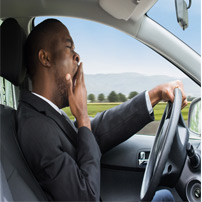MENU
- Home
- Overview
- Attorneys
- Practice Areas
- Firm News
- Blog
- Contact
 Many individuals now turn to ridesharing companies such as Lyft or Uber for their transportation needs. As independent contractors, the majority of ridesharing drivers are not screened for potential medical problems or tracked with respect to the number of hours they have been driving. This has resulted in an increasing public safety risk due to drowsy driving.
Many individuals now turn to ridesharing companies such as Lyft or Uber for their transportation needs. As independent contractors, the majority of ridesharing drivers are not screened for potential medical problems or tracked with respect to the number of hours they have been driving. This has resulted in an increasing public safety risk due to drowsy driving.
Drowsy driving occurs when a driver operates their vehicle under a state of extreme fatigue or sleepiness. Signs of drowsy driving can include a driver’s inability to keep their eyes open, extended periods of eye drooping, and drifting from one lane of traffic into another.
The Centers for Disease Control and Prevention (CDC) estimates that one in 25 drivers over the age of 18 have fallen asleep behind the wheel during the previous 30 days.
According to the AAA Foundation for Traffic Safety, drowsy driving was a factor in serious car accidents resulting in at least 6,400 deaths last year. Over 320,000 traffic accidents in the United States each year are attributed to drowsy driving. The CDC believes drowsy driving is underreported, and thus these numbers are, in fact, higher.
Ridesharing drivers can be particularly susceptible to drowsy driving. Many rideshare drivers operate their vehicles after extended periods of wakefulness or during the night, two of the risk factors for drowsy driving. This can lead to fatigue and sleeplessness – the primary causes of drowsy driving.
Ongoing medical conditions such as sleep apnea may also contribute to drowsy driving. Since ridesharing drivers often are not screened for medical conditions, this also increases the risk to public safety.
The American Academy of Sleep Medicine recently published a position statement in the Journal of Clinical Sleep Medicine highlighting the inherent safety risks in the ridesharing industry. Their position statement calls for a collaborative effort among ridesharing companies, government agencies, medical professionals, and law enforcement to reduce the public safety risk created by drowsy driving.
Ridesharing companies have begun to respond to the problem of drowsy driving. Lyft drivers must now take a six-hour break for every 14 hours of driving time. Uber requires its drivers to go offline for six consecutive hours after 12 hours of total driving time. It remains unclear how effective these limits will be, however, as many ridesharing drivers work for more than one ridesharing company.
If you or a loved one has been injured as a result of drowsy driving, compensation may be available. The experienced Wilmington car accident lawyers at Jacobs & Crumplar, P.A. work with drowsy driving accident victims to help them obtain the maximum compensation possible. We have offices conveniently located in Wilmington and Georgetown, Delaware to serve clients throughout the state. Contact us online or call us at 302-656-5445 to schedule a free consultation.